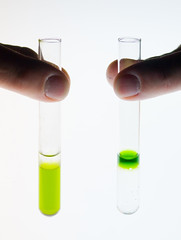Liquid biofuel, which is the one used in cars, is a natural and renewable domestic fuel that can only be used for diesel engines. This can be made from vegetable oils - mostly soy and corn. The nice thing about it is that it contains no petroleum, and is nontoxic and biodegradable.
By fueling up with biofuel, you decrease the pollutants in the air because it does not emit much of anything in the way of pollutants. Right now, it is the only fuel that is approved by the Environmental Protection Agency (EPA), has passed every Heath-Effects Test of the Clean Air Act, and meets the requirements of the California Air Resources Board (CARB).
| Bus running on soybean biodiesel. U.S. Department of Energy: Energy Efficiency and Renewable Energy (www.eere.energy.gov). (Photo credit: Wikipedia) |
One example of this type of fuel is biodiesel, which is made from alcohol like methanol and a chemical process that separates glycerine and methyl esters (biodiesel) from fats or vegetable oils. Aside from methanol, some countries have also experimented with corn and sugarcane to create their own version of biofuel.
Glycerine is a common product used in making toothpaste and soap. However, since the technology for this is fairly new, the process of converting it is quite expensive and right now, this is still much more expensive per gallon compared to petroleum (gasoline).
(Although if you look at what you pay for it, the returns are huge because you get to do your share to preserve a cleaner environment, an improvement in air quality and a reduction of cancer-causing agents.)
A cheaper and more primitive way to make bio-diesel is by collecting used cooking oil and then processing it. This may not be good your car’s engine so be careful if you decide to use it.
If you are skeptic about biodiesels, studies have shown that performance on the road is just as good as petroleum in terms of power to efficiency, hauling and climbing. You can use this in its pure form or blend with petroleum fuel. The most common mix in the market is 20/80 and is referred to as "B20." This means that 20% is biodiesel and the remainder is 80%. Another version is the E85 which is fuel composed of 85% ethanol and 15% gasoline.
The best part about using biodiesel is that you only have to make a few changes in your engine to be able to use it. Aside from making the car run, it also helps clean the engine. If you are concerned that this will void the warranty of your vehicle should there be a problem, don’t worry because it doesn’t. In the US, B20 is the most common one available but there are only a few gas stations that carry it. (E85 is becoming more common, but there are some concerns coming to light regarding lack of efficiency, and environmental issues due to overuse of farmland for intensive farming of corn to make this product.)
| Biofuels work at Argonne (Photo credit: Argonne National Laboratory) |
This never materialized because huge oil deposits were discovered and diesel was cheap. It was only when our demand for oil increased in the 1970’s, 1980’s, 1990’s and in the last decade or so that people began to realize that to reduce our demand for foreign oil that we should try using biodiesels and other forms of alternative energy. Developments in processing and efficiency continue to occur at an increasing pace, and we can look forward to seeing better biofuels on the market and readily accessible in the years to come.
That said, although improvements continue, we must keep in mind that some of these solutions may cause more problems than they fix, so it is important to look at all sides, and find the proper balance before choosing a green energy source. Check back Friday for an interesting video on the pros and cons of biofuels.



No comments:
Post a Comment